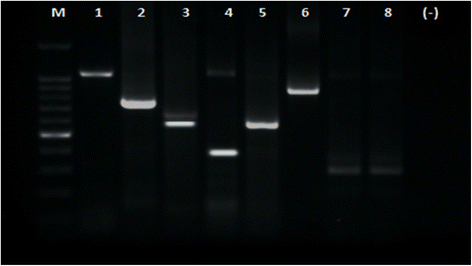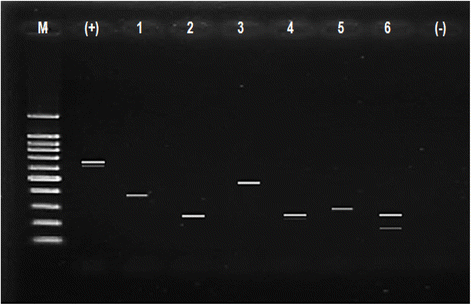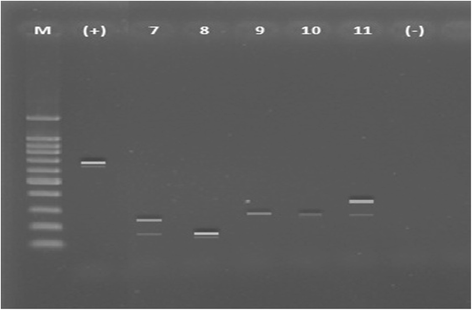Genotyping and clinical factors in pediatric diarrhea caused by rotaviruses: one-year surveillance in Surabaya, Indonesia
- PMID: 25793014
- PMCID: PMC4365806
- DOI: 10.1186/s13099-015-0048-2
Genotyping and clinical factors in pediatric diarrhea caused by rotaviruses: one-year surveillance in Surabaya, Indonesia
Abstract
Background: Rotavirus infections are a major cause of diarrhea in children in both developed and developing countries. Rotavirus genetics, patient immunity, and environmental factors are thought to be related to the severity of acute diarrhea due to rotavirus in infants and young children. The objective of this study was to provide a correlation between rotavirus genotypes, clinical factors and degree of severity of acute diarrhea in children under 5 years old in Surabaya, Indonesia.
Methods: A cross-sectional study was conducted in children aged 1-60 months with acute diarrhea hospitalized in Soetomo Hospital, Surabaya, Indonesia from April to December 2013. Rotavirus in stool specimens was identified by ELISA and genotyping (G-type and P-type) using multiplex reverse transcription PCR. Severity was measured using the Ruuska and Vesikari scoring system. The clinical factors were investigated included patient's age (months), hydration, antibiotic administration, nutritional state, co-bacterial infection and co-viral infection.
Results: A total of 88 children met the criteria; 80.7% were aged 6-24 months, watery diarrhea was the most common type (77.3%) and 73.6% of the subjects were co-infected with bacteria, of which pathogenic Escherichia coli was the most common (42.5%). The predominant VP7 genotyping (G-type) was G2 (31.8%) and that of VP4 genotyping (P-type) was P[4] (31.8%). The predominant rotavirus genotype was G2P[4] (19.3%); G1P[4] and G9P[4] were uncommon with a prevalence of 4.5%. There were significant differences between the common genotype and uncommon genotype with respect to the total severity score of diarrhea (p <0.05). G3, G4 and G9 were significantly correlated with severe diarrhea (p = 0.009) in multivariate analyses and with frequency of diarrhea (>10 times a day) (p = 0.045) in univariate analyses, but there was no significant correlation between P typing and severity of diarrhea. For combination genotyping of G and P, G2P[4] was significantly correlated with severe diarrhea in multivariate analyses (p = 0.029).
Conclusions: There is a correlation between rotavirus genotype and severity of acute diarrhea in children. Genotype G2P[4] has the highest prevalence. G3, G4, G9 and G2P[4] combination genotype were found to be associated with severe diarrhea.
Keywords: Clinical factors; Genotyping; Pediatrics; Rotavirus diarrhea.
Figures



Similar articles
-
Human rotavirus strains circulating in Venezuela after vaccine introduction: predominance of G2P[4] and reemergence of G1P[8].Virol J. 2017 Mar 21;14(1):58. doi: 10.1186/s12985-017-0721-9. Virol J. 2017. PMID: 28320411 Free PMC article.
-
Genetic diversity of species A rotaviruses detected in clinical and environmental samples, including porcine-like rotaviruses from hospitalized children in the Philippines.Infect Genet Evol. 2020 Nov;85:104465. doi: 10.1016/j.meegid.2020.104465. Epub 2020 Jul 17. Infect Genet Evol. 2020. PMID: 32687980
-
Prevalence and genotypes of group A rotavirus among outpatient children under five years old with diarrhea in Beijing, China, 2011-2016.BMC Infect Dis. 2018 Oct 3;18(1):497. doi: 10.1186/s12879-018-3411-3. BMC Infect Dis. 2018. PMID: 30285635 Free PMC article.
-
Rotavirus associated gastroenteritis in Thailand.Virusdisease. 2014;25(2):201-7. doi: 10.1007/s13337-014-0201-4. Epub 2014 Feb 23. Virusdisease. 2014. PMID: 25674586 Free PMC article.
-
Molecular epidemiology of group A rotavirus in outpatient diarrhea infants and children in Chongqing, China, 2011-2015.J Med Virol. 2019 Oct;91(10):1788-1796. doi: 10.1002/jmv.25530. Epub 2019 Jul 12. J Med Virol. 2019. PMID: 31241179
Cited by
-
Molecular Epidemiology and Clinical Features of Rotavirus Infection Among Pediatric Patients in East Java, Indonesia During 2015-2018: Dynamic Changes in Rotavirus Genotypes From Equine-Like G3 to Typical Human G1/G3.Front Microbiol. 2019 May 3;10:940. doi: 10.3389/fmicb.2019.00940. eCollection 2019. Front Microbiol. 2019. PMID: 31130934 Free PMC article.
-
Significance of continuous rotavirus and norovirus surveillance in Indonesia.World J Pediatr. 2018 Feb;14(1):4-12. doi: 10.1007/s12519-018-0122-1. Epub 2018 Feb 14. World J Pediatr. 2018. PMID: 29446040 Review.
-
Changing distribution of age, clinical severity, and genotypes of rotavirus gastroenteritis in hospitalized children after the introduction of vaccination: a single center study in Seoul between 2011 and 2014.BMC Infect Dis. 2016 Jun 14;16:287. doi: 10.1186/s12879-016-1623-y. BMC Infect Dis. 2016. PMID: 27296987 Free PMC article.
-
Characterization of changes in the intestinal microbiome following combination therapy with zinc preparation and conventional treatment for children with rotavirus enteritis.Front Cell Infect Microbiol. 2023 Sep 29;13:1153701. doi: 10.3389/fcimb.2023.1153701. eCollection 2023. Front Cell Infect Microbiol. 2023. PMID: 37842003 Free PMC article.
-
Rotavirus infection in children in Southeast Asia 2008-2018: disease burden, genotype distribution, seasonality, and vaccination.J Biomed Sci. 2020 May 21;27(1):66. doi: 10.1186/s12929-020-00649-8. J Biomed Sci. 2020. PMID: 32438911 Free PMC article. Review.
References
-
- UNICEF/WHO . Diarrhoea: Why children are still dying and what can be done. 2009. - PubMed
LinkOut - more resources
Full Text Sources
Other Literature Sources
Miscellaneous

